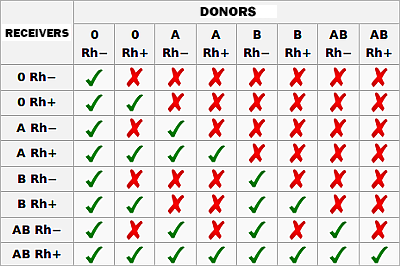Blood Groups
Donation
The Blood groups are determined by the presence of proteins on the surface af red blood cells.
Their appearance on the formation of the red blood cell is genetically determined, so ii can’t change during the life of on individual. These proteins act as antigens therefore also stimulating immune reactions.
This means that if we introduce in a subject (individual) red blood cells that do not belong to his same group, the body that receives them produces substances (antibodies) capable of combating these cell, so a rejection reaction. An antibody is a substance produced by the human body to fight and destroy foreign substances penetrate, integrating them in the complex defence system of the body. Returning to blood groups, of course everyone knows the AB0 system and the Rh factor, but in addition to these there are others less known like kell, lewis, etc.
The system AB0
In this system there are 4 different blood groups: A, B, AB e 0 (zero).
The four blood groups are characterized by the presence or assence of the antigenic proteins (above) A and B.
If on a red blood cell (red blood cell) there is the protein A one has the group A, if there is one of the protein B we have group B; the simultaneous presence of the 2 antigens characterize the AB group, if no one is present we have the group 0.
(The terminology currently used by us, that is the group “0”, is actvally a mispronunciation of the original “0” from german “ohne”, the is to say “no”, used by Landsteiner when he discovered the AB0 system).
For the reason that the individual recognizes as his own only the protein that he produces, and how alien those that he doesn’t produce do not produce, the blood makes antibodies directed against antigens that are not present on the surface of their red blood cells. It is important to note that these antibodies, called natural, do not require a previous contact with the antigen to be produced.
So, a person of group A will have anti B antibodies, a person of group B anti A antibodies, and a person of group 0, anti A and B antibodies, because neither the one nor the other are present on the surface of his red blood cells.
A person with the AB group, that has both the antigenic protein on the surface of its red blood cells, will not produce antibodies against these proteins; otherwise, it would destroy its red blood cells.
The Rh factor
Even if it’s called “factor”, the more correct terminology expect that also in this case we speak of (about) “system”. Also in this case we talk about a protein present or not on the surface of red blood cells.
If the protein is present we talk about Rh positive (Rh +), if it’s not present we talk about Rh negative (Rh-).
The name of this protein comes from the kind of monkey in which it was identified for the first time by Landsteiner and Wiener in 1941. These scholars in the course of comparative researches on the blood of humans and some monkeys noted, after repeatedly blood injections of Macao Rhesus (from here the name Rh) in the rabbit circulatory system, that the serum of this last one, put in contact with human blood, was agglutinating the red blood cell of 85% of white individuals.
This antigen was told factor Rhesus and the 85% of white individuals whose red blood cells are agglutinated by this factor are called Rh+, instead the other 15% Rh- .
When you make in the laboratory the determination of the blood group, in the phenotype this protein is indicated with the letter D (capital if it is present, lowercase letter if absent).
Unlike the AB0 system, the individuals with Rh- negative (that don’t have such a protein on the surface of their red blood cells) develop an antibody directed against this antigen only after contact with antigen D.
The presence or absence of this antigen is critical in pregnancy when the mother is Rh negative and the fetus Rh positive.

In the light of the above it is easy to understand that a donor 0 negative can donate blood to any group positive or negative, but can receive blood only from A donor 0 negative, instead A donor 0 positive can donate to any person, provided that Rh+, but can receive from any donor 0.
The individual AB+ can donate only to individual AB+, but can receive blood from every group positive or negative.


